Physical Address
304 North Cardinal St.
Dorchester Center, MA 02124
See Box 27-1 .
Heterotopia/ectopia of thyroid tissues
Lingual thyroid
Thyroglossal duct cyst
Lateral aberrant thyroid, parasitic nodule, and mechanical implantation
Mediastinal thyroid and other sites of thyroid tissue
Intranodal thyroid inclusions
Struma ovarii and associated lesions
Follicular epithelial metaplasia: squamous; oncocytic
Others
Intrathyroidal parathyroid tissue, thymic tissue, salivary gland tissue
Intrathyroidal epithelial (branchial cleft-like) cysts
Ultimobranchial apparatus rests
Intrathyroidal fat, muscle, and cartilage
Pigment and crystals in the thyroid
Iron; lipofuscin; crystals
Black thyroid (minocycline)
Acute inflammatory conditions
Infectious thyroiditis
Granulomatous thyroiditis (subacute thyroiditis; de Quervain)
Multifocal granulomatous thyroiditis (palpation thyroiditis)
Invasive fibrous thyroiditis (Reidel disease)
Radiation thyroiditis
Drug-induced thyroiditis
Infectious granulomatous thyroiditis
Sarcoidosis of the thyroid gland
Chronic (focal) lymphocytic thyroiditis
Chronic lymphocytic (Hashimoto) thyroiditis
Others
Autoimmune hyperthyroidism (diffuse hyperplasia or Graves disease)
Nodular goiter
Congenital inborn disorders (dyshormonogenetic goiter)
Amyloid goiter
Definitions: Heterotopia is the presence of otherwise normal-appearing tissue in an abnormal location. Ectopic thyroid tissue is the presence of thyroid in any location other than its normal anatomic position.
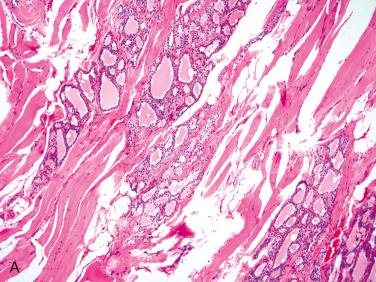
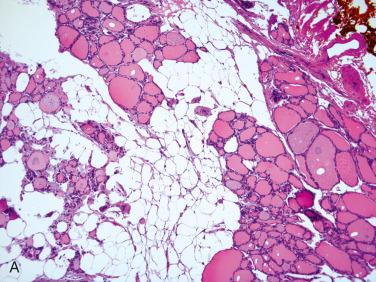
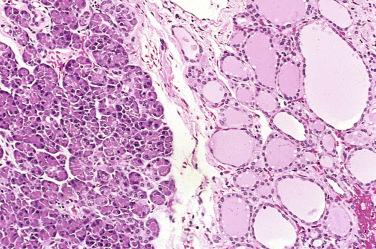
Synonyms: Aberrant thyroid rests; choristoma
Normal thyroid tissue can be found within the soft tissue structures (fat and muscle) of cervical neck:
Reflects developmental abnormality and should not be mistaken for malignancy:
Thyroid tissue in skeletal muscle often located at or around the isthmic portion of the gland
Absence of tissue response such as fibrosis (desmoplasia) and/or the presence of architectural or cytomorphologic changes indicative of a neoplasm (i.e., papillary carcinoma) are of assistance in differentiating normal (ectopic) thyroid tissue from neoplastic thyroid tissue.
Presence of thyroid tissue within lymph nodes especially located lateral to the jugular vein and carotid artery represents metastatic (papillary) carcinoma; exception would be thyroid tissue in a midline lymph node that may represent thyroid inclusions, but strict criteria must be applied to accept such thyroid tissue as inclusions and not metastatic tumor (see below).
Heterotopic thyroid tissue may be seen in any location from the tongue (foramen cecum at the base of the tongue) to the suprasternal notch (site of the normal gland):
May represent failure of descent from foramen cecum (median anlage) or, less likely, differentiation of thyroid tissue in abnormal locations
Excluding thyroglossal duct cysts, presence of heterotopic thyroid tissue is rare and almost exclusively seen in suprahyoid locations usually located in or close to midline:
Most common heterotopic focus for thyroid tissue is base of tongue, referred to as lingual thyroid (see below)
Other sites include (cranial to caudal direction):
Sella turcica
Submandibular region
Larynx
Trachea
Mediastinum (superior > posterior)
Aortic arch, pericardium, and heart
Esophagus
More distant sites of heterotopic thyroid tissue include:
Duodenal wall
Hepatobiliary (liver, porta hepatis, gallbladder, common bile duct)
Pancreas
Adrenal gland
Retroperitoneum
Vagina and inguinal region
Ovarian thyroid tissue is referred to as struma ovarii (see below).
Rarely, multiple ectopic thyroid tissue may be present in separate sites in same patient.
Diseases that affect thyroid gland proper may also affect ectopic thyroid tissues, including:
Inflammatory diseases (e.g., Hashimoto thyroiditis, Graves disease, others)
Goiter
Neoplasms
Imaging with 123 I may establish the diagnosis noninvasively.
Etiology:
None known
Rarely, familial thyroid heterotopia may occur.
Histologically, heterotopic thyroid tissue includes presence of normal-appearing, colloid-filled thyroid follicles:
Cytomorphologic findings include round to oval nuclei with coarse nuclear chromatin lacking constellation of nuclear features diagnostic for thyroid papillary carcinoma.
C-cells are absent.
Immunohistochemistry:
Unnecessary for identification but cells will be:
Reactive for thyroglobulin, thyroid transcription factor 1, PAX8, CD56
Nonreactive for calcitonin, neuroendocrine markers (e.g., synaptophysin, chromogranin)
Cytogenetics and molecular genetics:
Few reports evaluating molecular alterations in thyroid ectopia were without molecular alterations associated with malignant tumors of follicular cell derivation (BRAFV600E, N-RAS, H-RAS, K-RAS).
Any thyroid tissue found lateral to large neck vessels (i.e., carotid artery, jugular vein) should be considered metastatic tumor rather than ectopia:
Especially true for foci of thyroid follicles in lymph nodes:
Represent metastatic papillary thyroid carcinoma even in absence of diagnostic nuclear features
Different types of malignant neoplasms may be seen uncommonly associated with heterotopic tissues, including papillary carcinoma and follicular carcinoma:
In such circumstances, evaluation indicated to exclude origin from thyroid gland proper
In presence of malignant follicular-derived neoplasm within thyroid gland proper, presence of thyroid carcinoma in “ectopic” site represents metastatic disease.
Only in absence of malignant follicular-derived neoplasm within thyroid gland proper can presence of thyroid carcinoma in “ectopic” site be considered as originating from the ectopic site.
Presence of thyroid follicles in midline or paramidline lymph nodes may represent thyroid inclusions or metastatic papillary carcinoma (see Thyroid Tissue in Lymph Nodes later in this chapter).
In general, heterotopic thyroid tissue is benign.
Complete or partial agenesis of thyroid gland is extremely rare.
Definition: Developmental anomaly in which there is abnormal descent of thyroid gland with localization to base of tongue.
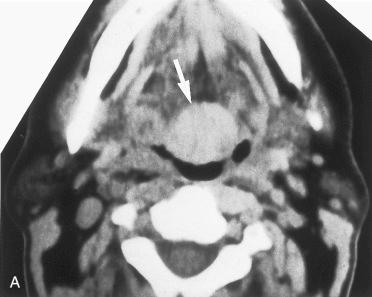
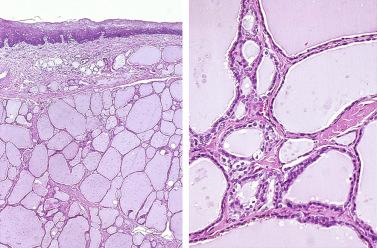
Thyroid tissue restricted to lingual region is rare, occurring in 1 in 100,000 persons.
Affects women more than men (3 : 1 to 7 : 1); most often diagnosed in adolescence but may occur over a wide age range from birth to the seventh decade of life
Most frequently seen along the midline of base of the tongue between the foramen cecum and the epiglottis; rarely, body of the tongue (sublingual) may be affected.
Majority of patients who are symptomatic are women; contributing factors are thought to be related to puberty, pregnancy, and menopause.
Most common symptom is dysphagia.
Lingual thyroid may grow large, resulting in dyspnea, orthopnea, and severe respiratory distress.
Other symptoms may include bleeding, voice changes, a foreign body sensation, snoring, and sleep apnea.
Clinical presentation:
70% of patients with symptomatic lingual thyroid are hypothyroid.
10% suffer from cretinism.
Hyperthyroidism exceptionally rare finding
In greater than 75% of patients, cervical thyroid tissue is absent (total migration failure) and lingual thyroid represents only thyroid tissue present:
In such situations surgical removal of lingual thyroid results in hypothyroidism.
Appropriate preoperative clinical work-up for lingual thyroid includes:
Routine blood work, including thyroid function tests thyrotropin, thyroxine, and thyroid hormone binding ratio
Scintigraphy with technetium or radioiodine studies, computerized tomography, or magnetic resonance imaging to:
Determine whether normally placed thyroid tissue is present or absent
Determine whether there are other ectopic foci of thyroid tissue (thyroid follicles may be found in hyoid region)
Determine functional activity of lingual thyroid tissue
Incisional biopsies must be performed with caution because this may cause sloughing of gland, infection, necrosis, or hemorrhage.
Radiology:
Tc-99m pertechnetate scanning is an efficient diagnostic tool that yields high-quality images in this clinical setting.
Computed tomography shows a mass at the base of the tongue with a greater density than the tongue.
On MR imaging, a well-defined mass of low-intermediate T2 signal in the midline base of the tongue, neither with invasive tendency nor with a cervical thyroid gland in the normal site, strongly indicates a lingual thyroid.
Submucosal varying in appearance from smooth to lobulated to nodular mass, with a red color, soft to firm consistency, and ranging in size from 2 to 3 cm:
Overlying mucosa may be intact or ulcerated.
Thyroid tissue is:
Submucosal and unencapsulated
May be nodular and hypercellular
Thyroid follicular epithelium is essentially normal in appearance (i.e., without evidence of papillary carcinoma).
May extend into skeletal muscle
Immunohistochemistry:
Unnecessary for identification but cells will be:
Reactive for thyroglobulin, thyroid transcription factor 1, PAX8, CD56
Nonreactive for calcitonin, neuroendocrine markers (e.g., synaptophysin, chromogranin)
Lymphoepithelial cyst of oral cavity
Cribriform adenocarcinoma of minor salivary glands of oral cavity (See Section 7):
May show histologic similarities to papillary thyroid carcinoma
Absence of immunoreactivity for thyroglobulin and TTF-1
Low-grade nasopharyngeal papillary adenocarcinoma (See Section 3):
May show histologic similarities to papillary thyroid carcinoma
Lesional cells are:
TTF-1 positive (nuclear staining)
Thyroglobulin negative
Therapy varies:
Asymptomatic euthyroid patients with ectopic thyroid do not usually require therapy but are kept under observation.
For symptomatic patients, surgical excision (intraorally or pharyngotomy) is preferred treatment:
Transoral robotic surgery (TORS) has provided minimally invasive approach to completely and safely excise ectopic lingual thyroid.
In patients without normally situated cervical thyroid tissue or other ectopic foci of thyroid tissue, auto-transplantation of thyroid tissue into the neck muscles can be done.
Other modes of therapy include:
Shrinking the mass by using thyroid hormones or use radioactive iodine ( 131 I) to ablate the lingual thyroid
Use of radioactive iodine results in destruction of other thyroid tissue and may also cause sloughing of the gland and hemorrhage.
In case of absence of orthotopic thyroid tissue, long-term thyroid hormone replacement recommended
Prognosis is good:
Surgical resection of lingual thyroid glands achieves significant improvement in patient symptoms with low rates of recurrence.
Complications of surgery are uncommon and may include:
Postoperative bleeding and epiglottic perforation, airway obstruction secondary to angioedema
Malignant neoplasms may arise from lingual thyroid:
Papillary thyroid carcinoma is the most common type.
May be associated with cervical nodal metastasis
Treatment best managed with surgical excision of all thyroid tissue followed by radioactive iodine ablation
In such circumstances, evaluation indicated to exclude origin from thyroid gland proper
In presence of malignant follicular-derived neoplasm within thyroid gland proper, presence of thyroid carcinoma in “ectopic” site represents metastatic disease.
Only in absence of malignant follicular-derived neoplasm within thyroid gland proper can presence of thyroid carcinoma in “ectopic” site be considered as originating from the ectopic site.
Definition: Persistence and cystic dilatation of thyroglossal duct in midline of the neck.
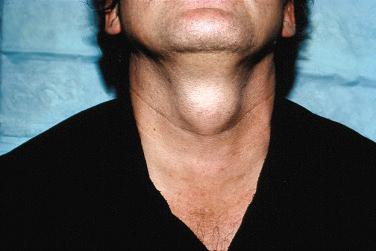
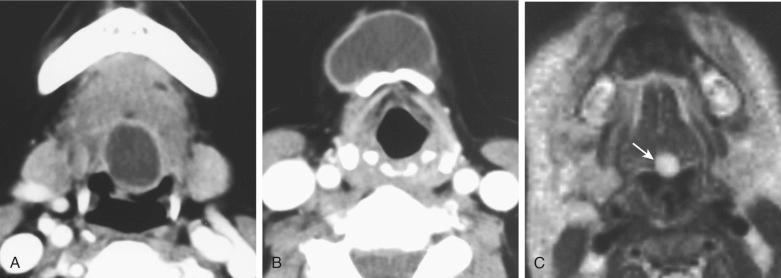
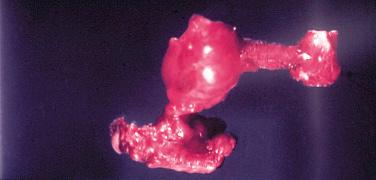
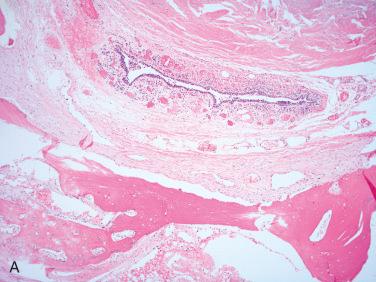
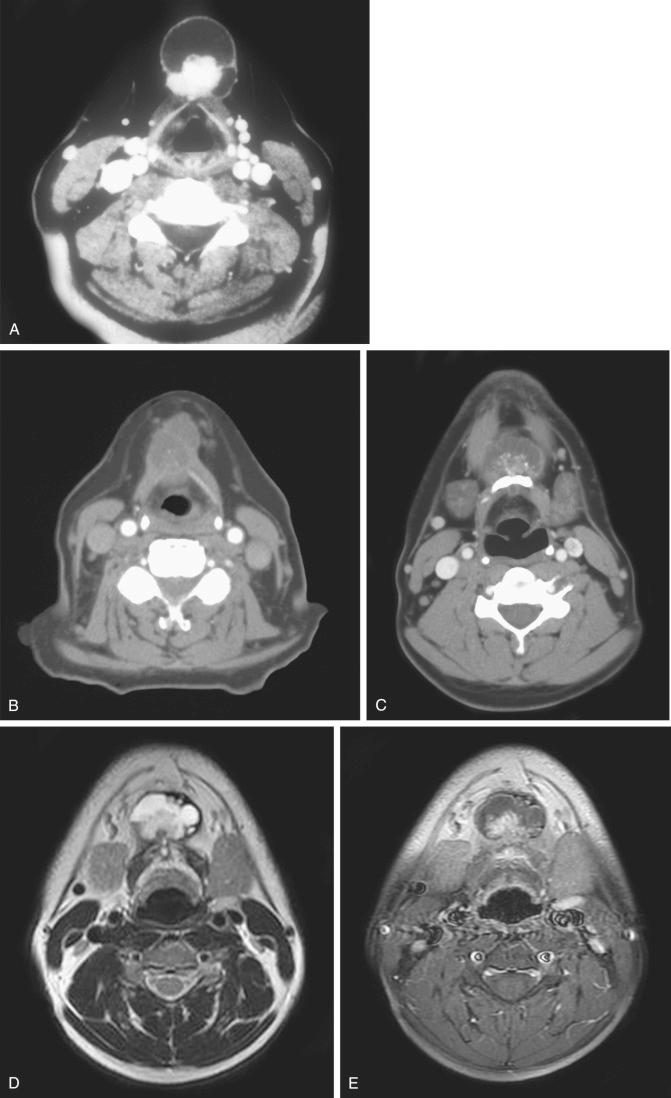
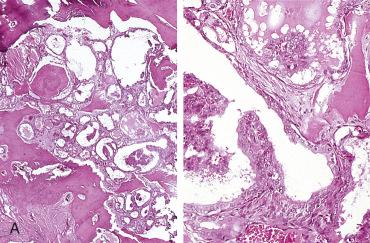
No gender predilection; occurs over a wide age range but the majority of patients present before the fourth decade of life
Majority of cases occur in the midline of the neck above the thyroid isthmus but below level of the hyoid bone:
Thyroglossal duct cysts are nearly always connected to hyoid bone.
Uncommonly, TDCs may occur lateral to midline but do not occur in the lateral portion of the neck (i.e., lateral to jugular vein).
Clinical presentation of an uninfected TDC usually that of asymptomatic midline neck mass:
Mass typically moves upward on swallowing.
Inflamed or infected TDCs may be associated with tenderness and pain.
Extrinsic airway compression in neonates with apnea, cyanosis, and respiratory compromise may uncommonly occur.
Radiology:
Midline round or elongated cystic lesion
Expansion and/or destruction of the cartilaginous structure of the hyoid bone may be seen.
Seldom contains enough thyroid follicular tissue to be seen on scintiscan
Presence of nodular soft tissue excrescences in a midline cystic neck mass on CT scan may suggest the possibility of a papillary carcinoma arising in a thyroglossal duct cyst.
Smears from thyroglossal cysts are low in cellularity, and inflammatory cells are more numerous than epithelial cells.
Squamous or respiratory epithelium may be identified.
Inflammatory cells, especially mature lymphocytes, are frequently present.
Smooth walled cystic structures usually measure less than 2 cm.
Cystic content includes clear mucinous fluid; infected cysts contain purulent material.
Epithelial-lined cystic proliferation within (hyoid) bone
In noninflamed cysts, the cysts lining is respiratory (columnar) epithelium but may also include squamous epithelium.
In presence of inflammation, cyst lining undergoes metaplastic change and is lined by squamous epithelium.
Presence of thyroid tissue in cyst wall varies and may be dependent on the extent of specimen sampling:
In general, thyroid tissue can be found in more than 60% of the cases.
Absence of thyroid tissue does not exclude diagnosis.
Thyroid tissue may be normal, hyperplastic, and nodular or neoplastic (see below).
Secondary retrogressive changes may be present, including:
Fibrosis
Chronic inflammatory cell infiltrate
Squamous metaplasia that may be focal or extensive
Thymic cyst
Metastatic (cystic) papillary thyroid carcinoma
Laryngocele
Branchial cleft cyst
Squamous cell carcinoma:
Presence of extensive squamous metaplasia may raise concern for possible presence of squamous cell carcinoma but metaplastic foci typically bland-appearing lacking cytomorphologic features of carcinoma
Surgery is preferred treatment:
Sistrunk procedure includes en bloc surgical resection of cyst, middle third of the hyoid bone, and suprahyoid tract up to base of tongue (foramen cecum).
Adequate surgery results in cure with low to no recurrences:
Reported recurrence rates range from 0% to 11%.
Extended surgical procedures prevent recurrence.
Benign and malignant neoplasms may occur in the setting of a thyroglossal duct cyst:
Benign tumors include follicular adenoma.
Development of a carcinoma in a thyroglossal duct cyst is rare:
Most carcinomas that develop in this setting are papillary carcinomas.
Rare examples of follicular carcinoma (oncocytic, nononcocytic types), undifferentiated (anaplastic) thyroid carcinoma, squamous (epidermoid) carcinoma, and adenosquamous carcinoma
Squamous (epidermoid) carcinoma and adenosquamous carcinoma in all probability arise from cyst lining rather than from thyroid cell component.
C-cell–related lesions, including medullary thyroid carcinoma, do not occur in thyroglossal duct cysts due to the different embryologic derivation of the C-cells.
Papillary thyroid carcinoma arising in the setting of a thyroglossal duct cyst:
Occur more commonly in women than men
Occur over a wide age range (first through eighth decades of life)
Are of usual morphologic type:
Variant types may include follicular variant, tall cell variant.
Similar (excellent) prognosis to that of papillary thyroid carcinoma arising in thyroid gland proper
May recur or metastasize and rarely may be lethal
Detailed evaluation of thyroid gland proper indicated
No clear consensus exists regarding optimal management, which may include:
Sistrunk procedure
Sistrunk procedure with total thyroidectomy
Sistrunk procedure with total thyroidectomy and neck dissection
Following total thyroidectomy:
Approximately one third may have concomitant papillary thyroid carcinoma in thyroid gland proper:
Often represent incidental papillary microcarcinomas
Nodal cervical metastasis may be present.
Such findings suggest that ultrasonography and, if warranted, fine-needle aspiration biopsy should be performed, and in presence of suspected lesion in thyroid gland proper and/or lymph node, Sistrunk procedure with total thyroidectomy, and neck dissection should be performed.
Definition: Refers to occurrence of thyroid nodule in the neck in which there is no connection to thyroid gland due to ablation of this connection or lack of identification of connection to the main gland:
Usually an expression of nodular hyperplasia (adenomatoid nodules) or nodular chronic lymphocytic (Hashimoto) thyroiditis
Less often expression of diffuse hyperplasia (i.e., Graves disease)
Synonyms: Sequestered thyroid nodule or accessory nodule
Lateral aberrant thyroid: former term used for thyroid tissue lateral to jugular vein:
Most of such cases, especially in lymph nodes, represent metastatic papillary thyroid carcinoma.
Many of such previously termed cases represent parasitic nodules.
“Aberrant” tissue may be connected to the thyroid by a thin fibrous strand that may or may not be appreciated by the surgeon or the pathologist, or there may not be a discernible attachment to thyroid gland proper.
May occur in the mediastinum as part of mediastinal nodular hyperplasia (goiter)
Stipulations for diagnosis of parasitic nodule include:
Aberrant thyroid tissue should be located in same fascial plane as thyroid gland.
Thyroid tissue not identified in relationship to a lymph node:
If thyroid tissue is seen within lymph node parenchyma, then it should be considered as metastatic carcinoma.
Presence of subcapsular sinuses assists in identifying given structure as being a lymph node.
In cases of lateral aberrant thyroid with associated lymphocytic thyroiditis, presence of a prominent lymphoid infiltrate gives the overall impression that the tissue is from a lymph node potentially leading to mistaken diagnosis of metastatic carcinoma:
Nodal tissue has subcapsular sinuses, whereas thyroid tissue with lymphocytic thyroiditis does not.
Aberrant thyroid tissue shows histopathologic changes similar to those seen in thyroid gland proper (e.g., lymphocytic thyroiditis, goitrous changes).
BRAF V600E mutation analysis reported in limited number of aberrant thyroid tissue was negative.
Mechanical implantation of thyroid tissue (normal or hyperplastic) refers to presence of thyroid tissue in the neck due to surgical intervention or trauma:
Unattached to thyroid gland may be the result of prior surgery or accidental trauma
In such instances, there usually is a prominent fibrotic reaction and/or suture material seen in association with the thyroid tissue.
Controversial issue whether benign thyroid inclusions in lymph nodes truly exist or whether all thyroid tissue located within a lymph node, irrespective of the nodal site or the degree of tumor differentiation, represents metastatic carcinoma from a primary thyroid tumor
In theory, it is conceivable that benign thyroid inclusions in lymph nodes may occur similar to nevus cell inclusions or salivary gland inclusions within lymph nodes; however, to consider a possible diagnosis of benign thyroid inclusion, strict criteria must be met, including:
Lymph node is located in midline, near midline, or medial to jugular vein.
Thyroid tissue is limited in extent (only a few follicles) located in nodal capsule and not found in subcapsular sinus(es), does not replace nodal parenchymal tissue, and/or is not found in multiple lymph nodes.
Inclusions are cytologically bland without histologic evidence to support diagnosis of metastatic papillary thyroid carcinoma.
Absence of psammoma bodies
Primary thyroid carcinoma is not present; however, this does not entirely exclude an occult primary tumor with metastatic (nodal) disease.
Even if the above criteria are met, a diagnosis of benign thyroid inclusions in lymph nodes should be made with caution as, in all likelihood, these foci represent metastatic papillary thyroid carcinoma (even in absence of cytomorphologic evidence of thyroid papillary carcinoma):
A diagnosis of metastatic carcinoma likely would result in thyroidectomy (lobectomy or total thyroidectomy).
Primary carcinoma often located in ipsilateral thyroid lobe but metastatic carcinoma in central compartment nodes may arise from anywhere in thyroid gland.
Primary carcinoma may be small and clinically undetectable.
Histologic identification of primary thyroid carcinoma may require exhaustive sectioning and histologic evaluation of resected thyroid gland, including:
Multiple levels of paraffin blocks
In absence of identifying primary carcinoma, “flipping” paraffin blocks and cutting multiple levels may be necessary
Even following exhaustive search primary carcinoma may not be detected, which does not exclude the primary residing in thyroid gland proper nor “rule in” benign thyroid inclusions.
Diagnosis of metastatic papillary thyroid carcinoma can be made if:
Thyroid tissue is located in a lymph node that is lateral to jugular vein and/or there is cytomorphologic evidence (i.e., nuclear features) diagnostic for papillary thyroid carcinoma irrespective of location of lymph node(s).
Diagnostic confusion may occur in setting of parasitic nodule (see above) with chronic lymphocytic (Hashimoto) thyroiditis:
In this setting, prominent lymphocytic thyroiditis, which may include germinal centers, could simulate the appearance of a lymph node so that thyroid tissue is considered as metastatic to a “lymph node.”
In contrast to lymph nodes, this tissue does not have subcapsular spaces, and thyroid follicular epithelium has changes associated with chronic lymphocytic (Hashimoto) thyroiditis, including cytoplasmic oxyphilia with enlarged nuclei lacking the constellation of cytomorphologic (nuclear) features of papillary thyroid carcinoma.
Immunohistochemistry:
In absence of known primary cancer, immunoreactivity for thyroglobulin confirms thyroid origin and differentiates metastatic thyroid carcinoma from carcinomas that may show histologic similarities to thyroid tumors, including salivary gland tumors (e.g., acinic cell carcinoma, mammary analogue secretory carcinoma, others) and non–head and neck cancers (e.g., lung, others).
Unlike thyroglobulin, TTF1 is not uniquely limited to lesions of thyroid gland origin.
Papillary thyroid carcinoma (and to a much lesser extent other thyroid type carcinomas) may originate in ovarian teratoma (i.e., struma ovarii), but such occurrences are rare and even rarer to metastasize to the head and neck (see below).
Limited diagnostic utility in differentiating benign thyroid inclusions from metastatic papillary thyroid carcinoma:
Benign inclusions and metastatic carcinoma are immunoreactive for thyroglobulin, TTF-1, PAX8
There may be some utility to using HBME1 (and CK19, galectin 3) in trying to differentiate benign inclusions (should be HBME1 negative) from metastatic papillary thyroid carcinoma (should show strong membranous HBME1 staining), but such staining is not sensitive or specific (see more detailed discussion in Chapter 28 under Papillary Thyroid Carcinoma).
BRAF and/or RET/PTC mutational analysis could assist in discriminating thyroid follicular epithelium in association with chronic lymphocytic thyroiditis ( BRAF or RET/PTC negative) from foci of papillary thyroid carcinoma ( BRAF or RET/PTC positive).
“Naked” psammoma bodies in lymph nodes:
Psammoma bodies are round calcific concretions showing concentric laminations.
Not entirely specific for papillary thyroid carcinoma but are exceptionally rare in benign thyroid diseases and in other thyroid carcinomas:
Represent important diagnostic clue to presence of papillary thyroid carcinoma
Found in approximately 50% of papillary thyroid carcinomas
Particularly common in tumors with classic papillary architecture and considered essentially pathognomonic for papillary thyroid carcinoma
Often seen in association with lesional cells showing typical nuclear features for papillary thyroid carcinoma but may be identified as isolated finding in thyroid parenchyma, in areas of inflammation, and/or in fibrotic areas without associated lesional cells that may be referred to as “naked” psammoma bodies
If present in lymph nodes chances are high that papillary carcinoma is present in lymph node with primary focus of carcinoma in (ipsilateral) thyroid lobe
Primary carcinoma may be very small and difficult to detect clinically and histologically.
Should be noted that presence of psammoma bodies is not limited to thyroid cancer and can be seen in association with other primary malignancies, including salivary gland tumors (e.g., acinic cell carcinoma, mammary analogue secretory carcinoma, polymorphous low-grade adenocarcinoma, cribriform adenocarcinoma of minor salivary glands, others), as well as primary non–head and neck malignant tumors (e.g., lung, ovary, thymus, others)
Generally considered rare for a primary salivary gland carcinoma to metastasize as a clinically occult primary carcinoma
Although presence of “naked” psammoma bodies in lymph nodes is highly correlated to metastatic papillary thyroid carcinoma, simply because there are accompanying psammoma bodies in lymph nodes does not necessarily equate to a diagnosis of metastatic (primary) thyroid carcinoma:
Histologic evidence in support of a thyroid origin and/or immunohistochemical confirmation (i.e., thyroglobulin) required
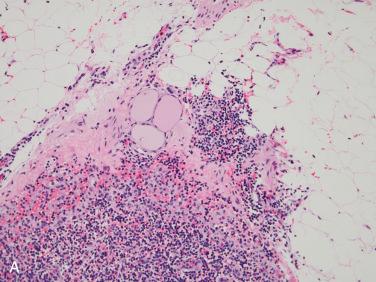
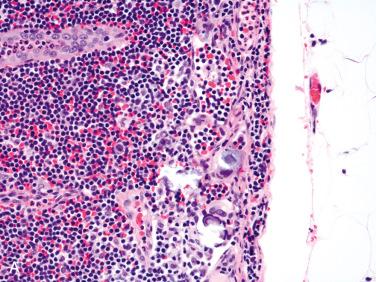
Definition: Presence of goitrous thyroid extending from thyroid gland proper into the mediastinum (substernal or retrosternal):
Most widely used definition is one in which >50% of total bulk of thyroid gland extends into mediastinum.
Additional consideration for substernal goiter is one that descends below plane of thoracic inlet.
Clinical parameters, including treatment of substernal goiter, are similar to those goiters (adenomatoid nodules) situated within the normally located thyroid (see later in this chapter).
As multinodular goiter enlarges, it has a tendency to move inferiorly due to fascial planes favoring this migration.
When thyroid gland enters the thoracic inlet, reduced pressure on inspiration may accelerate the migration:
Clinically, inferior part of gland cannot be determined due to its location behind the manubrium.
Goiters with intrathoracic extension usually lead to development of earlier and more severe symptoms:
Compression of trachea, esophagus, and great vessels more likely to occur in confined space or tracheal inlet
Exacerbation of symptoms may occur at night when patient is supine or lies on one side or other, or by certain positions that increase tracheal compression.
Occlusion of thoracic outlet may occur when arms extended over head
Referred to as Pemberton sign
Results in obstruction of venous return from head and neck region in visible venous distension over neck and plethoric changes in color of facial skin that may be associated with difficulty breathing and/or rarely syncope
Intrathoracic extension occurs primarily into anterior mediastinum:
Approximately 10% located in posterior mediastinum
Radiology:
On chest x-ray, an anterior mediastinal mass may be seen; thyroid scans ( 123 I) may show functional activity as well as the inferior extension of the thyroid gland.
Computed tomography and magnetic resonance imaging are extremely useful tools in the diagnosis of mediastinal goiters; features of a mediastinal mass seen on computed tomography (CT) that favor or suggest a thyroid origin (substernal goiter) include:
Anatomic continuity with the cervical thyroid
CT density greater than muscle
A rise in CT density and prolonged enhancement following contrast injection (≥2 minutes)
Multiple areas of calcification and proximity of the mass to the trachea
Tc-99m pertechnetate scintigraphy with and without oral administration of potassium perchlorate (KCLO4) administration is an accurate and cost-effective imaging method to diagnose retrosternal goiter:
Most mediastinal goiters are benign (adenomatoid nodules):
Thyroid malignancies can be seen in a mediastinal thyroid tissue and include:
Papillary carcinoma (microcarcinoma, classic type, follicular variant, others), follicular carcinoma, and undifferentiated (anaplastic) carcinoma
Mediastinal goiters generally do not respond to thyroid suppression and require surgical removal:
Further, due to the risk of sudden enlargement with possibility of airway compression or obstruction, intrathoracic goiters should be surgically removed.
Definition: Thyroid tissue differentiation occurring in setting of an ovarian teratoma.
Definition: Ovarian teratomas in which thyroid tissue is predominant (at least 50%) or sole tissue component.
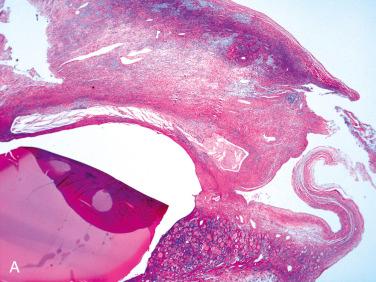
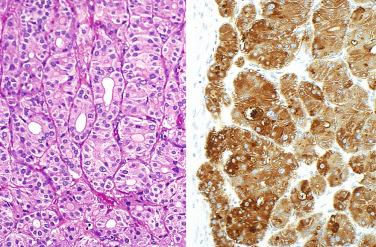
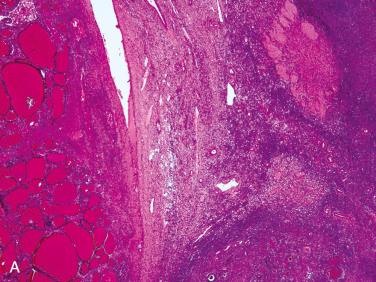
Presence of thyroid tissue within an ovarian teratoma varies and may be a function of adequate sampling:
Benign thyroid tissue occurs in from 5% to 15% of mature ovarian teratomas.
May occur in a wide range of ages including from second to ninth decades of life
Clinical presentation (of an ovarian teratoma, in general) is that of an abdominal mass and acute abdominal pain; rarely, may initially be detected as an ovarian mass complicating pregnancy.
Functional abnormalities may occur and include:
Hyperthyroidism
Rarely struma ovarii may coexist with Graves disease.
Patients may present with ascites that, in the presence of an ovarian mass, may be suspicious for ovarian carcinoma.
Ascites and hydrothorax (“pseudo-Meig syndrome”) may occur and may be associated with raised serum CA 125 levels.
Bilaterality may occur in 5% to 10% of cases.
Radiology:
CT shows cystic components with slightly high density.
MRI findings include the presence of multilocular cystic mass with a variable signal intensity within loculi.
Loculi or small cysts within septations may show low signal intensity on T1-weighted images and very low signal intensity on T2-weighted images.
Gd-DTPA enhanced T1-weighted images may show the presence of thick septations and locally thickened wall with marked enhancement (corresponding microscopically to thyroid tissue).
Often resembles nodular goiter, appearing as multiple glistening brown nodules
Thyroid tissue may be one of many tissue types of the teratoma representing only a minor component of ovarian teratoma; however, in those instances in which the thyroid tissue predominates (at least 50%) or is the sole component of the teratoma, the designation of struma ovarii is applied.
Histology of struma ovarii most often is that normal-appearing thyroid follicular tissue or as a multinodular goiter with colloid-filled variably sized follicles lined by flattened follicular epithelial cells:
Papillary hyperplasia of follicular epithelium can be seen.
Secondary degenerative changes such as fibrosis, cyst formation, and hemorrhage can occur.
Discrete mass lesions composed of densely cellular thyroid follicles (without evidence of malignancy) may be seen and have been termed proliferative struma ovarii.
Clear cell and signet ring cell cytoplasmic changes can occur.
Changes of lymphocytic thyroiditis may occur.
Immunohistochemistry:
Thyroglobulin reactivity:
Positive in struma ovarii, as well as in thyroid follicular neoplasms (benign and malignant) that occur in this setting
Thyroid transcription factor 1 (TTF-1) expressed in follicular epithelial cells, as well as in respiratory epithelium, if present
Calcitonin, chromogranin, and synaptophysin negative
Cytogenetics and molecular genetics:
Various molecular alterations identified in malignant struma ovarii (see below), including:
RET/PTC
BRAF
RAS
PAX8-PPARγ
Thyroid neoplasms arising in setting of struma ovarii are rare:
In theory, any neoplasm affecting the thyroid follicular epithelium proper can occur in setting of struma ovarii.
Most common type of thyroid neoplasm to occur in this setting is papillary thyroid carcinoma:
May be referred to as malignant struma
Most are conventional type and follicular variant; less commonly other variants reported, including tall cell variant
Diagnosis is based on finding architectural, but more importantly, on the cytomorphologic features of papillary carcinoma.
Invasive growth (vascular or stromal) is not required for a diagnosis of papillary carcinoma.
Follicular carcinoma may occur in the setting of struma ovarii:
In contrast to diagnosis of papillary carcinoma in this setting, a diagnosis of follicular carcinoma is based on presence of capsular or vascular invasion and absence of cytomorphologic features of papillary thyroid carcinoma.
Metastasis to ovary from a primary thyroid carcinoma:
Extraordinarily rare occurrence
Synchronous or metachronous papillary thyroid carcinoma within struma ovarii (malignant struma) and thyroid gland reported:
Rare case reports
Differences in microscopic features, immunohistochemical staining (HBME1, CK19, galectin-3), and molecular genetics (BRAF V600E, RAS, RET/PTC) reported
Treatment for ovarian teratoma including struma ovarii is surgical excision:
Unilateral salpingo-oophorectomy or total abdominal hysterectomy and salpingo-oophorectomy (unilateral or bilateral)
Surgical removal is curative.
In setting of benign struma ovarii, if there is a normally situated (cervical) thyroid gland without abnormalities, then surgical intervention relative to the normally situated thyroid gland not indicated
Treatment for malignant struma ovarii is surgical excision:
Unilateral salpingo-oophorectomy or total abdominal hysterectomy and salpingo-oophorectomy (unilateral or bilateral)
Total thyroidectomy also performed:
Required to treat with radioactive iodine
Metastatic disease from papillary carcinoma in struma ovarii may occur and include such sites as:
Contralateral ovary, peritoneum, regional lymph nodes, liver, and brain
Overall prognosis associated with malignant thyroid tumors in struma ovarii has been good:
89% 10-year survival
84% 25-year survival
Recurrence may occur within months or decades following initial resection.
Although unusual, fatalities secondary to widespread metastatic disease have occurred:
May occur years following initial diagnosis
Long-term follow-up indicated
Clinical features predictive of biologic malignancy in struma ovarii include:
Presence of adhesions, peritoneal fluid (> or = 1 L), or a serosal rent
Pathologic factors predictive of a poorer prognosis in struma ovarii include:
Large size (> or = 10 cm), strumal component more than 80%, extensive papillary carcinoma, especially with solid areas, necrosis, and increased mitotic activity (≥5 mitoses per 10 high-power fields)
So-called benign strumatosis has been used for presence of benign thyroid follicular epithelium within the peritoneum:
These foci should be considered as representing metastatic thyroid carcinoma.
Rare instances of non-Hodgkin malignant lymphomas have been reported in struma ovarii.
Definition: Ovarian tumor that includes presence of thyroid tissue admixed with carcinoid tumor:
In this setting, other teratomatous elements are usually absent.
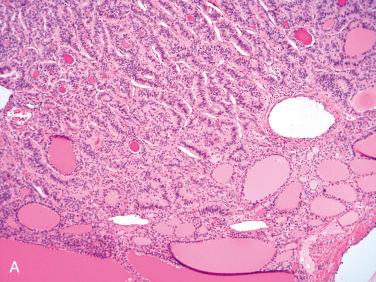
Majority of women with strumal carcinoids are postmenopausal, but this tumor may occur over a wide age range from the third through eighth decades of life.
Clinical presentation is similar to that of any ovarian teratoma presenting as an enlarging abdominal mass or identified as an incidental finding on routine gynecologic (or urologic) evaluation.
Other (uncommon) clinical presentations may include:
Constipation, pain on defecation, virilization, hirsutism, symptoms related to function of the thyroid component, and association with multiple endocrine neoplasia 2A:
Peptide YY found in association with symptoms of constipation
Extremely rare occurrence of carcinoid syndrome has been reported.
Similarly rare occurrence of carcinoid heart disease has been reported.
Rarely reported in association with struma ovarii and malignant transformation, including follicular variant of papillary thyroid carcinoma, mucinous cystadenomacarcinoma, and strumal carcinoid
Histogenesis of strumal carcinoid remains controversial:
Most likely, histologic elements of this tumor arise from a common progenitor cell such as gives rise to the ovarian teratoma (i.e., endodermal germ cell)
No evidence to support C-cell origin for carcinoid component
Characterized by presence of normal thyroid follicular tissue admixed with carcinoid tumor:
Diagnosis is made as long as both components are present and is not based on whether one or the other predominates.
Carcinoid component:
Trabecular growth
Composed of cells with small round to oval nuclei with dispersed (“salt and pepper”) chromatin
Rarely, acellular eosinophilic extracellular material representing stromal amyloid deposition is present.
Rarely, carcinoid component may be of mucinous type (mucus-secreting cells).
Follicular epithelial component composed of colloid-filled follicles lined by flat to columnar cells with round to oval nuclei and coarse nuclear chromatin:
Birefringent calcium oxalate monohydrate crystals are identified in the colloid material.
Teratomatous elements, including cutaneous and respiratory epithelium, can be identified.
A dense fibrous stroma is present.
Histochemistry:
Carcinoid component will be argentaffin and argyrophilic positive.
Immunohistochemistry:
Synaptophysin, chromogranin, NSE, and serotonin positive in carcinoid component
Calcitonin only rarely identified
Neurohormonal peptides that can be present include pancreatic polypeptide, glucagon, somatostatin, vasoactive intestinal polypeptide, and substance P.
Thyroglobulin and TTF-1 negative in carcinoid component but thyroglobulin and TTF-1 reactive in noncarcinoid thyroid follicular component of strumal carcinoid
Prostatic acid phosphatase (PAP) may be present in carcinoid component:
Similar findings as identified in rectal (hindgut) carcinoids
Electron microscopy:
Neurosecretory granules can be seen.
Atypical carcinoid:
Extraordinarily rare examples reported
As compared to (typical) strumal carcinoid tumor shows greater degree of nuclear pleomorphism, higher mitotic rate, and focal necrosis
May metastasize including to bone
Treatment is surgical removal.
May include:
Unilateral salpingo-oophorectomy in younger-age patients
Bilateral oophorectomy and hysterectomy in older-age patients
Prognosis:
Considered excellent following surgical removal even in presence of metastatic tumor
Fatalities have been reported.
Definition: A benign process in which there is a phenotypic alteration from one cell type to another cell type.
Benign process in which the normal follicular epithelium changes to one with squamous cell features
Can occur in a wide variety of settings ( Box 27-2 )
Nodular goiter (adenomatoid nodules) with or without retrogressive changes
Chronic (focal) lymphocytic thyroiditis
Hashimoto thyroiditis and variants
Following fine-needle aspiration biopsy or incisional biopsy
Developmental:
Solid cell nests (squamoid foci)
Thymic rests (Hassall corpuscles)
Papillary thyroid carcinoma
Diffuse sclerosing variant of papillary thyroid carcinoma
Primary squamous cell carcinoma
Primary mucoepidermoid carcinoma
Metastatic squamous cell carcinoma to the thyroid
Teratoma
Clinical features in which squamous metaplasia occurs based on the pathologic process in which it appears
Most often, squamous metaplasia of thyroid follicular epithelium seen in setting of lymphocytic thyroiditis and in adenomatoid nodules with retrogressive changes, the latter occurring spontaneously or secondary to traumatic event such as a prior fine-needle aspiration biopsy
Not infrequently may be seen in association with papillary thyroid carcinoma (with or without lymphocytic thyroiditis)
Alternative theory to squamous metaplasia of follicular epithelial cells is origin from solid cell nests of ultimobranchial derivation:
Bulk of evidence favors follicular epithelial cell origin for presence of squamous cells in thyroid gland.
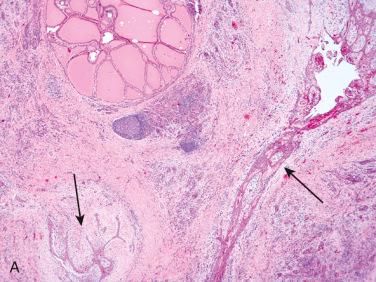
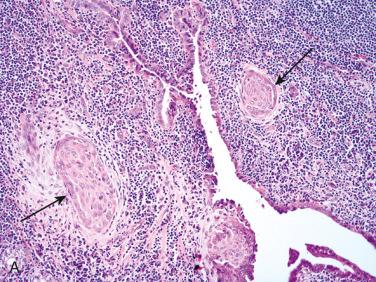
Histology of squamous metaplasia includes:
Bland appearance in which nests of cells are round to oval (including “morule” formation) without infiltrative growth
Keratinization and intracellular bridges can be seen.
Basaloid cells may be present.
Cytologic atypia absent, including:
Lack of significant pleomorphism and atypia
Low nuclear-to-cytoplasmic ratio
Mitotic figures can be seen but are limited in number and atypical mitoses not present.
Absence of associated mucous cells
Extent of squamous metaplasia may be:
Focal (more common)
Extensive (less common)
Immunohistochemistry:
Cytokeratin (AE1/AE3) positive
Variable reactivity for thyroglobulin, TTF-1 may be negative
p63 positivity can be seen with predominant positivity at periphery of cell nests.
Calcitonin, chromogranin, carcinoembryonic antigen (CEA), and high molecular weight keratin (e.g., 34βE12) negative
Mutational analysis:
BRAF and RAS negative
Primary thyroid squamous cell carcinoma and mucoepidermoid carcinoma (MEC) (see Chapter 28 ):
Both thought to arise from squamous metaplasia of thyroid follicular epithelial cells
Majority of cases of squamous metaplasia lack the cytologic atypia and/or infiltrative growth of squamous cell carcinoma.
Absence of admixture of epidermoid cells, mucous cells, and intermediate cells allows differentiation from MEC.
Predicated on setting in which the squamous metaplasia occurs
Definition: Oncocytic (oxyphilic) metaplasia is derived from the Greek word meaning “swollen” and results from an increase in mitochondrial content of a cell.
By light microscopy, an oncocytic cell is one that has prominent granular eosinophilic-appearing cytoplasm.
Oncocytic change not limited to the thyroid but occurs in many nonendocrine organs (e.g., salivary glands, others) as well as in other endocrine organs (pituitary gland, parathyroid gland, adrenal glands).
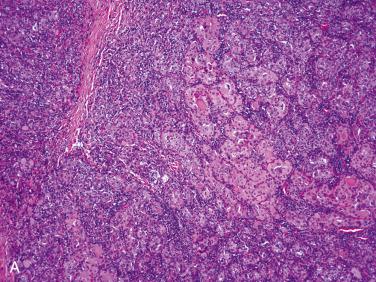
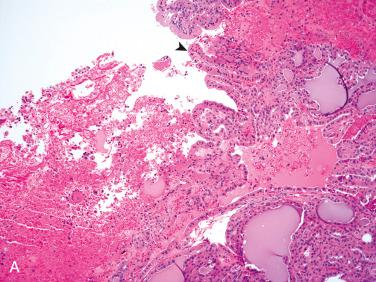
Synonyms: Hürthle cell is a designation restricted to oncocytic cells in thyroid gland; in all other (extrathyroidal) sites, use of the terms oncocyte or oxyphilic cell interchangeable
Several points regarding the presence of oncocytic cells include:
Hürthle originally described cell now thought to represent the parafollicular cell or C-cell of ultimobranchial derivation and not oncocyte
Askanazy originally described oncocytic cell in thyroid gland.
Use of designation oncocytic cell, oxyphilic cell, or Hürthle cell in relationship to thyroid lesions is purely descriptive and indicative of a type of change in a cell and NOT indicative (in and of itself) of a specific diagnosis or of any specified biologic behavior:
Too often, clinicians are under the assumption that a “Hürthle cell neoplasm” is malignant and is synonymous with a follicular carcinoma.
Erroneous assumption, oncocytic cell changes can be seen in non-neoplastic and neoplastic (benign and malignant) thyroid lesions ( Box 27-3 )
Nodular goiter (adenomatoid nodules)
Autoimmune thyroiditis
Chronic lymphocytic (Hashimoto) thyroiditis
Graves disease
Post-radiation
Aging
Follicular adenoma, oncocytic variant
Follicular carcinoma, oncocytic variant
Papillary thyroid carcinoma, oncocytic variant
Medullary thyroid carcinoma, oncocytic
May occur in solid cell nests (oncocytic solid cell nests)
Histologically, an oncocytic cell characterized by presence of an abundant eosinophilic granular-appearing cytoplasm
Oncocytic cytoplasmic changes:
Associated with enlargement of the cell nucleus:
This alteration in nuclear size may lead to an erroneous diagnosis of papillary thyroid carcinoma.
Diagnostic confusion may be minimized by:
Evaluating the setting in which changes are occurring (e.g., presence of a prominent lymphocytic cell infiltrate as seen in chronic lymphocytic thyroiditis)
Evaluating for other changes that may support a diagnosis of papillary thyroid carcinoma, in particular constellation of nuclear changes that in addition to nuclear enlargement includes nuclear variation in size and shape, clear to very fine-appearing nuclear chromatin, margination of chromatin along nuclear membrane, nuclear crowding and overlapping, nuclear grooves, and nuclear pseudoinclusions
In addition to enlarged nuclei, cytoplasmic oncocytic change is often associated with prominent central-located eosinophilic nucleoli
Retrogressive changes:
Oncocytic cells perhaps due to oxygen-sensitive nature of mitochondria may be easily traumatized, leading to marked degenerative changes following such events as fine-needle aspiration or core biopsy:
Degenerative changes may include pseudopapillary or papillary growth, infarction, necrosis, and hemorrhage.
Clear cell changes in follicular epithelial cells represent a degenerative process and may be associated and perhaps arise from oncocytic metaplasia.
Special stains for mitochondria include:
Phosphotungstic acid hematoxylin (PTAH): red granular appearance
Novelli stain: dark purple appearance
Immunohistochemistry:
Cytokeratin and vimentin positive
Weakly thyroglobulin reactive; TTF1 positive
Synaptophysin, chromogranin, and calcitonin negative
Electron microscopy:
Cytoplasm filled with mitochondria showing abnormalities in size, shape, and content
No specific treatment:
Treatment and prognosis are predicated on the setting in which the oxyphilic cell changes are seen.
Embryologic development of the thyroid gland in association with the branchial and pharyngeal pouches allows for incorporation of other branchial and pharyngeal pouch-derived endodermal and mesodermal structures within the thyroid gland.
Branchial and pharyngeal pouch endodermal structures found within thyroid gland include:
Parathyroid tissue, thymic tissue, and salivary gland tissue
Presence of these heterotopic tissues is generally an incidental finding and not cause for surgical removal of thyroid gland.
Heterotopic parathyroid tissues found within substance of thyroid gland (intrathyroidal) and not outside the thyroid gland (beyond the capsule)
Finding parathyroid tissue outside gland reflects inadvertent surgical removal of parathyroid gland(s) at time of thyroid gland resection.
Incidental parathyroidectomy not uncommon (13.8%) after thyroidectomy and usually not associated with postoperative biochemical hypocalcemia
In theory, any pathologic process that affects these tissues in their normal anatomic locations may occur when they are found within thyroid tissue; however, in general, histologic appearance of heterotopic tissues is within normal limits and pathologic changes of these tissues (i.e. hyperplasia, neoplasia) are rare:
Intrathyroidal hyperfunctioning parathyroid glands can occur.
Hyperparathyroidism related to these intrathyroidal parathyroid glands most often due to a parathyroid adenoma and, less often, due to an intrathyroidal parathyroid carcinoma or hyperplasia
Intrathyroidal thymic-related neoplasms and salivary gland tumors are rare.
Assessment for patients with hyperparathyroidism may include preoperative noninvasive imaging studies, including neck ultrasound, nuclear medicine scan (technetium-99m-pertechnetate uptake), neck and mediastinal computed tomography scan, and neck and mediastinal magnetic resonance imaging that may localize parathyroid lesions within thyroid gland.
At times, it may be difficult to histologically differentiate thyroid tissue from parathyroid tissues:
Overlapping histomorphologic features of thyroid and parathyroid tissues may include:
Clear cell or oncocytic cytoplasmic changes
Presence of follicle formation with luminal colloid-like material
Features of parathyroid tissue that may be of assistance in differentiating it from thyroid follicular cells include:
Overall smaller cell size
Hyperchromatic nuclei
Sharp cell borders
Clear cytoplasm
Mixture of different cell types (chief cells, oncocytic cells, clear cells)
More pronounced nesting and/or trabecular growth pattern
More delicate vascular pattern
Presence of parathyroid hormone, parafibromin, synaptophysin, and chromogranin with absence of thyroglobulin immunoreactivity
Histologic identification of thymic tissue (presence of Hassall corpuscles) and salivary gland parenchyma usually not problematic
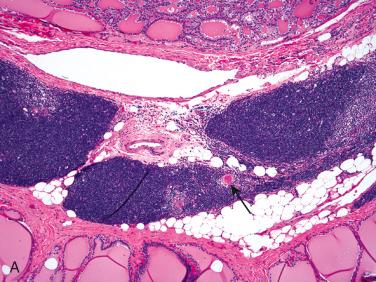
Considered uncommon
Predominantly occur in adults
Majority of these cysts are incidentally found in thyroid glands removed for other reasons; occasionally, cysts may attain large sizes presenting as thyroid mass.
Clinically detectable cysts may appear as a “cold” nodule on thyroid scan and rarely as a “hot” nodule.
Radiographic (sonographic) imaging may suggest thyroid neoplasm.
Histogenesis:
Due to histologic similarities to branchial cleft cysts, these intrathyroidal cystic structures have been postulated as being of branchial cleft derivation; however, histogenesis not known.
Among the considerations is that these intrathyroidal cysts:
Part of spectrum of changes associated with chronic lymphocytic (Hashimoto) thyroiditis representing secondary changes (i.e., squamous metaplastic foci with cystic change)
In support of a metaplastic alteration with associated cyst formation (which we favor) is the fact that:
Chronic lymphocytic (Hashimoto) thyroiditis invariably present in thyroid gland in which the intrathyroidal cysts are seen
Identical cysts present as incidental findings in cases of lymphocytic thyroiditis.
Cystic lesions often are multifocal and bilateral.
Acquired representing cystic degenerative changes of a pre-existing lesion (nodule or neoplasm)
Originate from developmental rests in thyroid such as solid cell nests (SCN), which represent vestiges of branchial cleft-derived ultimobranchial apparatus
In support of this consideration is identification of other branchial cleft-derived structures (e.g., parathyroid glands, thymus) in the thyroid gland
Histologically:
Cystic lesions vary in size from small and indiscrete to large and dominant.
Dense fibrous capsule may separate cystic lesion from surrounding thyroid tissue.
Cysts predominantly lined by squamous epithelium consisting of one or multiple layers of cells
Columnar cell (respiratory-type) epithelium can be seen (with or without cilia):
May contain goblet cells that stain for mucin
Intermixed with squamous epithelium
Dense lymphocytic cell infiltrate seen deep to cystic epithelial lining and may include lymphoid aggregates with reactive germinal centers
Cysts almost invariably occur in association with chronic lymphocytic thyroiditis (Hashimoto thyroiditis or nonspecific chronic thyroiditis).
Immunohistochemistry
Cystic epithelial lining:
Reactive with cytokeratins and carcinoembryonic antigen (CEA)
Nonreactive for thyroglobulin, calcitonin, or chromogranin
Cysts are of limited biologic concern.
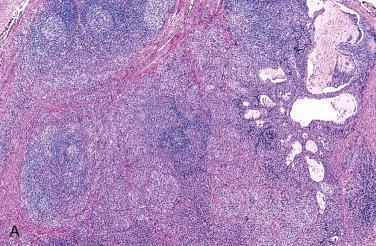
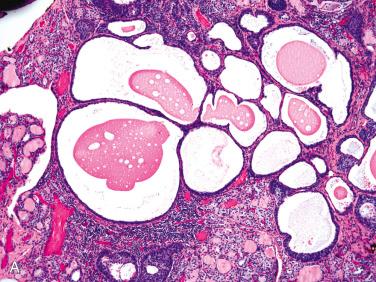
Synonyms: Solid ultimobranchial apparatus nests; cystic SNC
Although the subject of debate, SCN probably are cellular remnants of ultimobranchial apparatus.
SCN generally incidentally found in thyroid glands removed for other reasons
When found, SCN localize to lateral lobes (posterolateral and posteromedial aspects) reflecting the migration of ultimobranchial apparatus-derived thyroid cells exclusively to lateral thyroid lobes:
SCN as well as C-cell hyperplasia and medullary thyroid carcinoma are not found and do not occur in the isthmic portion of thyroid gland.
SCN are not uncommon and can be found in more than 25% of resected thyroid glands:
Identification of SCN is a function of tissue sampling
SCN are generally of no biologic concern.
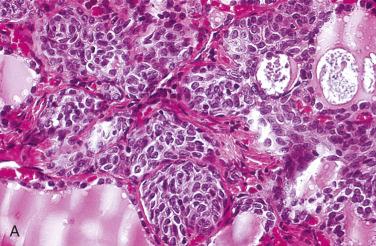
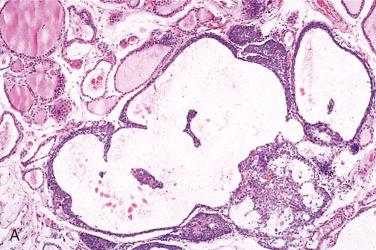
Most measure 0.1 mm on average but may attain larger sizes.
Appear as small, discrete cell nests, cords, or clusters interspersed among thyroid follicles
Thought to be composed of two cell types, main cells and C-cells:
Predominant (main) cells composed of epithelial cells with:
Round to oval-shaped cells with elongated to round-appearing nuclei, finely granular nuclear chromatin, and acidophilic cytoplasm
Nuclear grooves may be present.
Squamoid (epidermoid) differentiation may be present.
Keratinization (horny pearl formation or individual cell) and intercellular bridges are not found.
Cystic change may be present:
Referred to as cystic SCN
Lined by flattened multilayered epithelium most often with squamoid features and less commonly by ciliated columnar epithelium
Dense eosinophilic intraluminal material may be present.
Rarely, oncocytic cytoplasmic change reported (oncocytic solid cell nests):
Acquire mitochondrial alterations similar to those seen in follicular cells and C-cells
Second less prominent C-cells composed of cells with clear-appearing cytoplasm and round nuclei
May merge with thyroid follicle to create so-called mixed follicle
Mucicarminophilic material can be found:
Presence of mucosubstances in SCN thought to be degenerative changes of epidermoid cells, possibly representing true endodermal-derived C-cell conglomerates
Immunohistochemistry:
Main cells are:
Cytokeratins (AE1/AE3, CAM5.2, CK903 (34βE12), CK7, CK19) positive
CK20 negative
Strongly express p63, as well as carcinoembryonic antigen
Galectin 3 positive
Typically negative for thyroglobulin, TTF-1, HBME1, calcitonin, and parathyroid hormone
C-cells are:
Positive for calcitonin, chromogranin, synaptophysin
Positive for cytokeratins (AE1/AE3, CAM5.2, and CK 7)
Thyroglobulin negative
Focal immunoreactivity for TTF-1 can be found.
p63 negative
These findings demonstrate a dual cell population in solid cell nests with main cells of the solid cell nests displaying a basal/stem cell phenotype (p63 and basal cytokeratin positivity) and C-cells showing features of parafollicular differentiation.
Cytogenetics and molecular genetics:
Single case of SNC hyperplasia reported to demonstrate BRAF (V600E) mutation and BRAF (G593D) mutation
Supporting histogenetic link between main cells of SNC and papillary thyroid carcinoma
Suggesting solid cell nest hyperplasia as precursor lesion of papillary thyroid carcinoma
Papillary thyroid carcinoma
Medullary thyroid carcinoma
Similar to heterotopic endodermal structures found in thyroid gland, heterotopic mesodermal-derived structures such as fat, muscle, and cartilage can also be identified within thyroid gland.
Synonyms: Hamartomatous adiposity; adenolipomatosis; adipose metaplasia
Rarely, mature adipose tissue can be found within thyroid gland under normal conditions.
Mature adipose tissue in thyroid gland can also be found in association with numerous pathologic conditions or lesions, including:
Adenomatoid nodules, amyloid goiter, lymphocytic thyroiditis, thyroid atrophy, follicular adenoma (adenolipoma), papillary carcinoma, follicular carcinoma, and rarely, diffuse hyperplasia and dyshormonogenetic goiter
Presence of (non-neoplastic) mature adipose tissue in thyroid gland is an incidental finding found in excision of gland for other reasons.
Amount and distribution of mature fat varies from a few adipocytes in a limited portion of gland to substantial collections in multifocal sites and/or diffuse infiltration.
Adipose tissue is intimately admixed with thyroid tissue and does not appear as a separate, solid mass lesion such as would appear in an adipose neoplasm.
Mature adipocytes appear as fairly uniform cells with some variation in size and shape that are characterized by presence of clear to vacuolated cytoplasm compressing and eccentrically displacing cell nucleus; nuclei are hyperchromatic without pleomorphism.
Rarely, foci of extramedullary hematopoiesis may be seen within adipose tissue.
Mechanism by which mature adipose tissue is found in thyroid gland is not known
Some possible explanations include:
Embryologic rests
Metaplasia from stromal fibroblasts
Senile involution
True neoplastic component
Benign and malignant lipogenic tumors of the thyroid gland are extraordinarily uncommon.
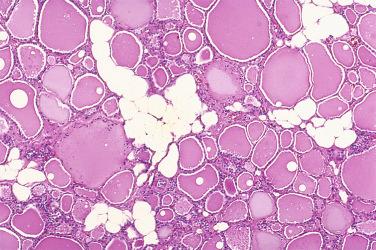
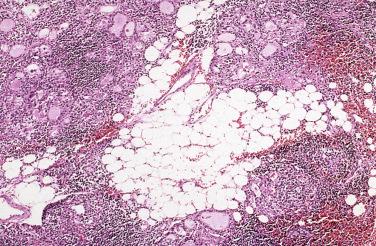
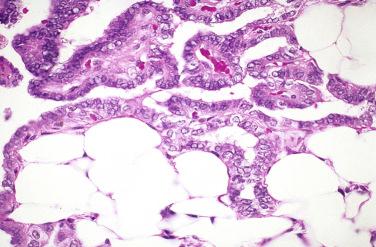
Similar to adipose tissue in thyroid glands, presence of skeletal muscle is an incidental finding and may be seen in thyroid gland under normal conditions as well as in variety of pathologic conditions.
Presence of (non-neoplastic) skeletal muscle in thyroid gland is an incidental finding found in excision of gland for other reasons.
Skeletal muscle typically found in association with isthmic portion of thyroid gland or pyramidal lobe
Skeletal muscle is intimately admixed with thyroid tissue and does not appear as a separate, solid mass lesion such as would appear in a myogenic neoplasm.
Thyroid tissue in skeletal muscle is cytologically benign without findings diagnostic for malignancy.
Benign and malignant myogenic tumors of the thyroid gland are extraordinarily uncommon.
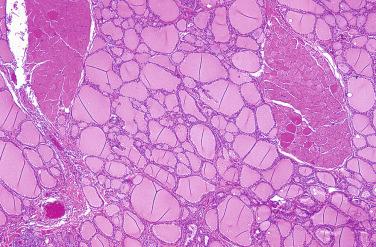
As with fat and skeletal muscle, mature cartilage can be found in the thyroid gland (adenochondroma); when found it is as an incidental finding found in glands removed for other reasons.
Cartilage in thyroid gland may also occur as a metaplastic process seen in association with some pathologic conditions (e.g., adenomatoid nodules).
Benign and malignant cartilaginous tumors of the thyroid gland are extraordinarily uncommon.
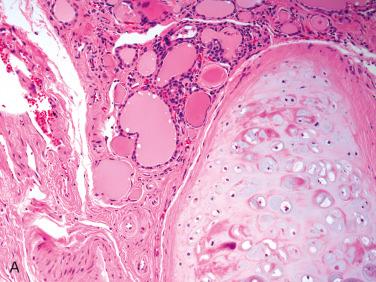
Following hemorrhage with release of iron from red blood cells, resorption takes place and iron is converted to hemosiderin, which is stored in cell cytoplasm of phagocytizing cells (macrophages) as well as in thyroid follicular cells.
In thyroid gland, hemosiderin can be found in virtually all pathologic conditions and represents an incidental finding.
Reflects secondary phenomenon due to hemorrhage and can follow trauma (e.g., post–fine-needle aspiration biopsy, core biopsy) identified in adenomatoid nodules or various neoplasms
Hemosiderin may be found in macrophages, within the stromal tissues, or within the follicular epithelial cells:
Hemosiderin is readily apparent in hematoxylin- and eosin-stained slides and appears as intracytoplasmic coarse brown to yellow pigment.
If necessary, iron stains (Prussian blue, Mallory) can be used to identify iron and distinguish it from other pigments.
Rarely, iron can be stored in the thyroid as a component of a disorder of iron metabolism rather than a secondary phenomenon due to hemorrhage.
Most cases of iron deposition not associated with thyroid dysfunction:
Uncommonly, secondary hypothyroidism may develop.
Lipofuscin pigment represents degenerative (aging) phenomenon in which there is intracytoplasmic accumulation of small yellow to light brown granular-appearing pigment.
In thyroid gland, lipofuscin pigment can be seen within follicular epithelial cells.
True nature of lipofuscin has yet to be determined, but it has been shown to react with:
Lipid (Sudan IV) and lipofuscin stains
Shows diastase-sensitive, periodic acid-Schiff positive intracytoplasmic material
Shows lysosomes by electron microscopy
Contains the presence of histidine and tryptophan
Iron staining is absent.
Lipofuscin deposition in thyroid gland is an incidental finding, more often seen in thyroid glands from older individuals.
There is no evidence to indicate that presence of lipofuscin within any cell, including thyroid follicular cells, causes dysfunction or functional compromise of that cell.
Minocycline, a tetracycline derivative, administered to adults for treatment of various reasons (infections, acne) may cause black pigmentation and discoloration of various sites, including skin and thyroid gland.
Thyroid involvement referred to as black thyroid
Presence of minocycline-related pigmentation of thyroid gland is, by and large, not associated with glandular enlargement (hyperplasia) nor functional abnormalities of gland.
Rarely, hypothyroidism may be seen in minocycline pigmentation of thyroid gland.
Rarely, follicular adenoma, follicular carcinoma, and papillary thyroid carcinoma may be associated with minocycline-induced black thyroid.
Minocycline pigment appears within cytoplasm of follicular epithelial cells as granular and black to brown:
Pigment can also be seen within follicle lumina as large black to brown deposits admixed with colloid.
Minocycline shares histochemical, electron microscopic, and elemental analysis features with lipofuscin, including:
Positive staining with periodic acid-Schiff (PAS), lipid, and lipofuscin stains
Presence of lysosomes and autofluorescence
Argentaffin stains (Fontana) may be positive.
Iron staining negative
Increase in vimentin staining in follicular epithelium compared with normal control thyroid glands
Thyroglobulin and ubiquitin staining in follicular epithelium is reduced compared with control thyroid tissues.
True “makeup” of minocycline pigment is still not fully known; possibilities include:
Degradation products of drug combined with lipofuscin
Oxidation degradation of the drug
Drug interaction and alteration of tyrosine metabolism
Lysosomal dysfunction
Localization of pigment may vary from case to case such that in presence of adenomatoid nodules or an adenoma pigment can be seen:
In pathologic component of gland and not surrounding uninvolved thyroid
In uninvolved thyroid but not in pathologic component of gland
In pathologic component of gland and surrounding uninvolved thyroid parenchyma
Antidepressant agents may be associated with red pigmentation of thyroid gland felt to be due to lysosomal accumulation of drug.
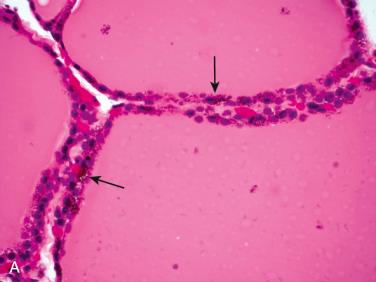
Intracolloidal crystals are not infrequently found in thyroid gland under normal conditions as well as in a pathologic condition.
Finding of intracolloidal crystals not associated with any specific diagnosis and may be found in virtually all thyroid abnormalities:
Highest prevalence of crystals occurs in association with benign diseases and is most commonly seen in nodular goiters followed by follicular adenomas.
Crystals may be found in association with malignant tumors (e.g., papillary carcinomas, follicular carcinomas), but prevalence is low.
Low prevalence of crystals seen in association with Graves disease, lymphocytic thyroiditis, and subacute thyroiditis
Frequency of finding crystals within thyroid gland appears to increase with age.
Intrathyroidal crystals are exclusively found within colloid and do not appear within cytoplasm of the follicular epithelial cells or in stromal tissues.
Crystals may be found by fine-needle aspiration, but occurrence of crystals in thyroid fine-needle cytology is lower than that in histologic specimens.
Crystals are readily apparent by light microscopy; polarization enhances their detection.
Crystals vary in size and shape and appear in a variety of geometric shapes.
Chemical analysis of crystals indicates that they are composed of calcium oxalate.
Finding intracolloidal crystals may be a function of increasing age and/or disease state.
A separate population of patients who have increased frequency of intracolloidal crystals are those undergoing hemodialysis for chronic renal failure.
Occurrence of crystals in normal human thyroid is associated with a low-functional state of the thyroid follicles.
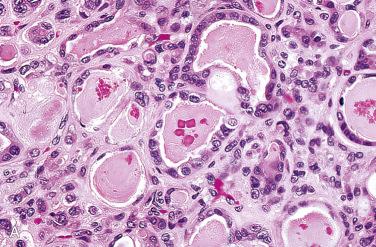
Definition: Disorder in which thyroid gland is unable to synthesize and secrete sufficient amounts of thyroid hormone to meet requirement of brain and peripheral tissues.
Primary hypothyroidism: Thyroid failure that results from disease of thyroid gland, including clinical and pathologic state that results from decreased production and subnormal amount of circulating thyroid hormone; accounts for 99% of all cases of hypothyroidism.
Secondary hypothyroidism: Result of decreased thyroid stimulation by thyroid-stimulating hormone (TSH) due to pituitary disease.
Tertiary hypothyroidism: Result of decreased thyroid stimulation by thyroid-stimulating hormone (TSH) due to a decrease in pituitary stimulation resulting from a deficiency in thyrotropin releasing hormone (TRH).
Central or hypothyrotropic hypothyroidism: Synonyms for secondary and tertiary hypothyroidism.
Most common clinical disorder of thyroid function
Most often caused by disorder of thyroid gland leading to decrease in thyroidal production and secretion of thyroxine (T 4 ) and triiodothyronine (T 3 ) invariably accompanied by increased thyrotropin (TSH) secretion
May result from diseases or treatments that destroy thyroid tissue or interfere with thyroid hormone biosynthesis
Causes of hypothyroidism are listed in Box 27-4 :
Worldwide, iodine deficiency most common cause of hypothyroidism
In areas where iodine intake is adequate, most common causes are chronic autoimmune thyroiditis and radiation-induced hypothyroidism secondary to radioactive iodine treatment of hyperthyroidism.
Chronic autoimmune thyroiditis (atrophic and goitrous forms)
Radiation treatment ( 131 I therapy, external radiotherapy to head and neck for nonthyroid malignant disease)
Surgery (total or subtotal thyroidectomy)
Iodine deficiency
Drug-induced (antithyroidal medications: lithium, iodine, and iodine-containing drugs and radiographic contrast material)
Infiltrative diseases of thyroid (amyloidosis, scleroderma)
Defective thyroid hormone biosynthesis
Congenital defects in thyroid hormone biosynthesis
Developmental abnormalities (thyroid dysgenesis)
Pituitary disease (neoplasms, infarcts, trauma)
Hypothalamic disease (neoplasms, infectious disease, trauma)
Silent (painless) thyroiditis (including postpartum thyroiditis)
Subacute thyroiditis
After withdrawal of thyroid hormone therapy in euthyroid patients
Equal gender predilection; may occur in all age groups but more commonly affects adults
May be clinically overt or subclinical; subclinical hypothyroidism is defined as elevated serum TSH and normal thyroxine (T 4 ) and T 3 concentrations.
Clinical manifestations independent of cause:
Overt hypothyroidism defined as:
High serum TSH concentrations and low serum free T 4 concentrations
Many but not all patients have symptoms and signs of hypothyroidism but clinical spectrum of severity may be broad even in overt hypothyroidism such that some patients may have very subtle manifestations of disease (few signs and symptoms), whereas others may have more extreme manifestations (myxedema coma).
Subclinical hypothyroidism defined as:
High serum TSH concentrations (usually <10 mU/L) and normal serum free T 4 concentrations
Patients typically have few or no symptoms and signs of hypothyroidism.
Clinical symptoms and signs of hypothyroidism include (in no particular order):
Fatigue, lethargy, sleepiness, mental impairment, depression, cold intolerance, slow movements, slow speech, hoarseness, bradycardia, dry skin, decreased perspiration, nonpitting edema, anemia, decreased appetite, constipation, weight gain, arthralgia, hyporeflexia, paresthesia, menstrual abnormalities (typically menorrhagia), and infertility
Three types of clinical evidence suggest hypothyroidism:
Symptoms and signs consistent with thyroid hormone deficiency
Evidence of diseases, previous treatment, or exposure known to cause thyroid or pituitary failure
Presence of disorders associated with increased risk of chronic autoimmune thyroiditis
Myxedema:
Severe hypothyroidism sometimes referred to as myxedema but myxedema is not synonymous with hypothyroidism
Represents accumulation of glycosaminoglycans in soft tissues (subcutaneous and other interstitial sites), resulting in nonpitting edema of hypothyroid patients
Most common in severe (long-standing) primary hypothyroidism
Factors potentially influencing clinical features of hypothyroidism include:
Patient age:
In children and adults effects are potentially reversible.
In infants, hypothyroidism may result in irreversible mental and physical retardation (see below, endemic cretinism) unless treatment is initiated early.
Presence of other diseases:
If there is not generalized destruction of thyroid gland, compensatory increase in TSH secretion may maintain thyroid secretion at near normal levels so that the clinical manifestations of hypothyroidism may remain subclinical for years.
Rate at which hypothyroidism develops:
Those patients with rapid onset of hypothyroidism have more symptoms than those patients who develop it gradually.
Laboratory testing:
Low serum free thyroxine (T 4 ) levels and elevated serum thyroid-stimulating hormone (TSH) levels confirm presence of hypothyroidism.
Serum triiodothyronine (T 3 ) concentrations also decline but not frankly low until thyroidal T 3 -secretion and hepatic T 4 –to-T 3 conversion.
Generalized myxedema:
Develops in patients with long-standing, severe generalized thyroid deficiency
Clinical features result from glycosaminoglycan accumulation in soft tissues resulting in a full face, nonpitting periorbital and cutaneous edema (most marked around the hands), which does not resorb during recumbency (unlike cardiogenic edema).
The soft tissue fluid accumulation is composed of a mixture of mucopolysaccharides, hyaluronic acid, and chondroitin sulfate.
Fluid may accumulate in virtually every part of the body, some of these sites in which fluid accumulation occurs due to thyroid deficiency and result in clinical signs and symptoms
Cardiovascular (myxedema heart):
Most common cardiovascular abnormality of hypothyroidism is pericardial effusion
Other changes relate to cardiac papillary muscle contractile abnormalities, electrical abnormalities resulting in sinus bradycardia as seen by electrocardiographic changes such as prolonged QT intervals, flattening and inversion of T waves, and in children the so-called mosque sign with a dome-shaped T wave and partially obliterated ST segment.
Radiographic findings include cardiomegaly.
Incidence of atherosclerotic cardiovascular disease is increased in hypothyroid patients.
Pulmonary:
Direct pulmonary effects, including altered pulmonary function tests, depressed ventilatory drives, pleural effusions, decreased surfactant production in the neonate
Indirect pulmonary effects, including phrenic nerve paralysis, congestive heart failure causing pulmonary edema, obesity causing atelectasis, others
Neurologic manifestations
Psychiatric disturbances most prominently depression
Adults with acquired hypothyroidism have propensity to develop entrapment neuropathies (e.g., carpal tunnel syndrome).
Mental retardation and cretinism well-recognized complications of endemic iodine deficiency and untreated overt congenital hypothyroidism
Myxedema coma:
Rare syndrome represents severe life-threatening hypothyroidism.
Most frequently occurs in elderly women with long-standing hypothyroidism
More likely to occur in winter months possibly associated with extreme cold
Other possible precipitating factors include infection, drugs (anesthetics, sedatives, tranquilizers, narcotics, lithium), trauma, cerebrovascular accidents, congestive heart failure.
Cardinal features include hypothermia and unconsciousness.
High mortality rates in untreated patients
Should be viewed as a medical emergency
Rapid diagnosis with immediate initiation of appropriate therapy is key in preventing death; therapy includes ventilatory support, control of water and electrolyte imbalances, temperature control, administration of hydrocortisone therapy in the presence of coexisting adrenal insufficiency, and initiation of thyroid hormone therapy.
Renal:
Alterations in renal hemodynamics and kidney function resulting in generalized fluid retention
Extravascular accumulation of protein-rich fluid (albumin and other proteins) results in weight gain but there is a decrease in the plasma volume and a fall in cardiac output.
Upper aerodigestive tract:
Airway obstruction due to goiter, enlarged tongue, pharyngeal muscle dysfunction
Uncommonly myxoid polyps of larynx occur in hypothyroid patients.
Other manifestations of hypothyroidism include:
Infectious complications:
Increased susceptibility to infections of respiratory tract, urinary tract, and skin reported in hypothyroid patients
Hematologic:
Anemia is common in hypothyroidism (seen in up to 30% to 40% of patients).
Anemia most often normo- or macrocytic and normochromic and represents a normal physiologic response:
Thyroid hormone has a stimulatory effect on erythropoiesis via erythropoietin.
Deficiency in thyroid hormone leads to decrease in erythropoiesis due to slowing of metabolic rate, decrease in oxygen requirement, and decrease in erythropoietin levels.
Small percentage of hypothyroid patients (2% to 15%) have microcytic anemia.
Little significant effects on white blood cells and platelets occur.
Myxedematous endemic cretinism:
Occurs in areas of endemic goiter and severe iodine deficiency
Represents most serious complication of endemic goiter
In severe endemic goiter, irreversible abnormalities of intellect and physical development occur in a high number of patients.
Clinically includes:
Mental deficiency with defects in hearing and speech
Disorders of standing and gait
Hypothyroidism and stunted growth
Iodine deficiency is fundamental in cause of endemic cretinism and if severe enough, may be the only factor causing cretinism.
Other factors may include natural-occurring goitrogens, thyroid autoimmunity, trace element deficiency (selenium, manganese), congenital infections and perinatal anoxia.
No specific therapy
Rehabilitation is similar to patients with cerebral palsy.
Prevention is by efficient iodine prophylaxis.
Treatment of hypothyroidism
May be as simple as replacing thyroxine (T 4 ) using levothyroxine (LT 4 )
Considered preferred treatment for hypothyroidism
Most patients treated with LT 4 as single agent
In some instances, hypothyroidism does not result from destruction of gland but due to another cause ( Box 27-4 ) not be remedied by levothyroxine (LT 4 ) replacement.
In these instances, identification and treatment of underlying cause is paramount in controlling effects of hypothyroidism.
Become a Clinical Tree membership for Full access and enjoy Unlimited articles
If you are a member. Log in here